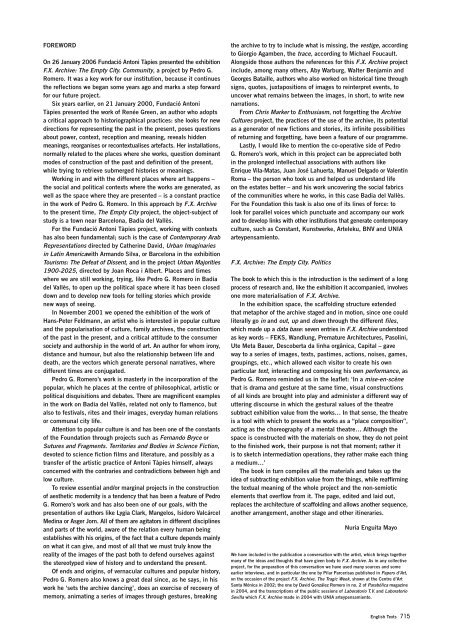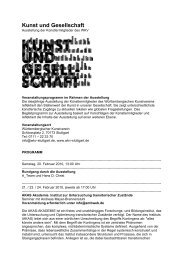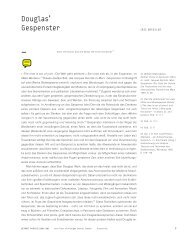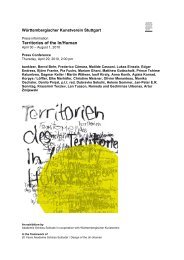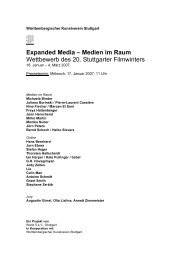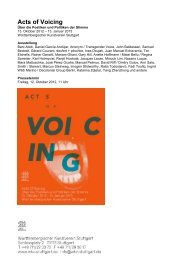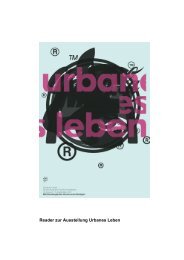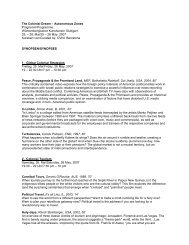English Texts
English Texts
English Texts
You also want an ePaper? Increase the reach of your titles
YUMPU automatically turns print PDFs into web optimized ePapers that Google loves.
FOREWORD<br />
On 26 January 2006 Fundació Antoni Tàpies presented the exhibition<br />
F.X. Archive: The Empty City. Community, a project by Pedro G.<br />
Romero. It was a key work for our institution, because it continues<br />
the reflections we began some years ago and marks a step forward<br />
for our future project.<br />
Six years earlier, on 21 January 2000, Fundació Antoni<br />
Tàpies presented the work of Renée Green, an author who adopts<br />
a critical approach to historiographical practices: she looks for new<br />
directions for representing the past in the present, poses questions<br />
about power, context, reception and meaning, reveals hidden<br />
meanings, reorganises or recontextualises artefacts. Her installations,<br />
normally related to the places where she works, question dominant<br />
modes of construction of the past and definition of the present,<br />
while trying to retrieve submerged histories or meanings.<br />
Working in and with the different places where art happens –<br />
the social and political contexts where the works are generated, as<br />
well as the space where they are presented – is a constant practice<br />
in the work of Pedro G. Romero. In this approach by F.X. Archive<br />
to the present time, The Empty City project, the object-subject of<br />
study is a town near Barcelona, Badia del Vallès.<br />
For the Fundació Antoni Tàpies project, working with contexts<br />
has also been fundamental; such is the case of Contemporary Arab<br />
Representations directed by Catherine David, Urban Imaginaries<br />
in Latin Americawith Armando Silva, or Barcelona in the exhibition<br />
Tourisms: The Defeat of Dissent, and in the project Urban Majorities<br />
1900-2025, directed by Joan Roca i Albert. Places and times<br />
where we are still working, trying, like Pedro G. Romero in Badia<br />
del Vallès, to open up the political space where it has been closed<br />
down and to develop new tools for telling stories which provide<br />
new ways of seeing.<br />
In November 2001 we opened the exhibition of the work of<br />
Hans-Peter Feldmann, an artist who is interested in popular culture<br />
and the popularisation of culture, family archives, the construction<br />
of the past in the present, and a critical attitude to the consumer<br />
society and authorship in the world of art. An author for whom irony,<br />
distance and humour, but also the relationship between life and<br />
death, are the vectors which generate personal narratives, where<br />
different times are conjugated.<br />
Pedro G. Romero’s work is masterly in the incorporation of the<br />
popular, which he places at the centre of philosophical, artistic or<br />
political disquisitions and debates. There are magnificent examples<br />
in the work on Badia del Vallès, related not only to flamenco, but<br />
also to festivals, rites and their images, everyday human relations<br />
or communal city life.<br />
Attention to popular culture is and has been one of the constants<br />
of the Foundation through projects such as Fernando Bryce or<br />
Sutures and Fragments. Territories and Bodies in Science Fiction,<br />
devoted to science fiction films and literature, and possibly as a<br />
transfer of the artistic practice of Antoni Tàpies himself, always<br />
concerned with the contraries and contradictions between high and<br />
low culture.<br />
To review essential and/or marginal projects in the construction<br />
of aesthetic modernity is a tendency that has been a feature of Pedro<br />
G. Romero’s work and has also been one of our goals, with the<br />
presentation of authors like Lygia Clark, Mangelos, Isidoro Valcárcel<br />
Medina or Asger Jorn. All of them are agitators in different disciplines<br />
and parts of the world, aware of the relation every human being<br />
establishes with his origins, of the fact that a culture depends mainly<br />
on what it can give, and most of all that we must truly know the<br />
reality of the images of the past both to defend ourselves against<br />
the stereotyped view of history and to understand the present.<br />
Of ends and origins, of vernacular cultures and popular history,<br />
Pedro G. Romero also knows a great deal since, as he says, in his<br />
work he ‘sets the archive dancing’, does an exercise of recovery of<br />
memory, animating a series of images through gestures, breaking<br />
the archive to try to include what is missing, the vestige, according<br />
to Giorgio Agamben, the trace, according to Michael Foucault.<br />
Alongside those authors the references for this F.X. Archive project<br />
include, among many others, Aby Warburg, Walter Benjamin and<br />
Georges Bataille, authors who also worked on historical time through<br />
signs, quotes, juxtapositions of images to reinterpret events, to<br />
uncover what remains between the images, in short, to write new<br />
narrations.<br />
From Chris Marker to Enthusiasm, not forgetting the Archive<br />
Cultures project, the practices of the use of the archive, its potential<br />
as a generator of new fictions and stories, its infinite possibilities<br />
of returning and forgetting, have been a feature of our programme.<br />
Lastly, I would like to mention the co-operative side of Pedro<br />
G. Romero’s work, which in this project can be appreciated both<br />
in the prolonged intellectual associations with authors like<br />
Enrique Vila-Matas, Juan José Lahuerta, Manuel Delgado or Valentín<br />
Roma – the person who took us and helped us understand life<br />
on the estates better – and his work uncovering the social fabrics<br />
of the communities where he works, in this case Badia del Vallès.<br />
For the Foundation this task is also one of its lines of force: to<br />
look for parallel voices which punctuate and accompany our work<br />
and to develop links with other institutions that generate contemporary<br />
culture, such as Constant, Kunstwerke, Arteleku, BNV and UNIA<br />
arteypensamiento.<br />
F.X. Archive: The Empty City. Politics<br />
The book to which this is the introduction is the sediment of a long<br />
process of research and, like the exhibition it accompanied, involves<br />
one more materialisation of F.X. Archive.<br />
In the exhibition space, the scaffolding structure extended<br />
that metaphor of the archive staged and in motion, since one could<br />
literally go in and out, up and down through the different files,<br />
which made up a data base: seven entries in F.X. Archive understood<br />
as key words – FEKS, Wandlung, Premature Architectures, Pasolini,<br />
Ute Meta Bauer, Descoberta da linha orgânica, Capital – gave<br />
way to a series of images, texts, pastimes, actions, noises, games,<br />
groupings, etc., which allowed each visitor to create his own<br />
particular text, interacting and composing his own performance, as<br />
Pedro G. Romero reminded us in the leaflet: ‘In a mise-en-scène<br />
that is drama and gesture at the same time, visual constructions<br />
of all kinds are brought into play and administer a different way of<br />
uttering discourse in which the gestural values of the theatre<br />
subtract exhibition value from the works… In that sense, the theatre<br />
is a tool with which to present the works as a “place composition”,<br />
acting as the choreography of a mental theatre… Although the<br />
space is constructed with the materials on show, they do not point<br />
to the finished work, their purpose is not that moment; rather it<br />
is to sketch intermediation operations, they rather make each thing<br />
a medium…’<br />
The book in turn compiles all the materials and takes up the<br />
idea of subtracting exhibition value from the things, while reaffirming<br />
the textual meaning of the whole project and the non-semiotic<br />
elements that overflow from it. The page, edited and laid out,<br />
replaces the architecture of scaffolding and allows another sequence,<br />
another arrangement, another stage and other itineraries.<br />
Nuria Enguita Mayo<br />
We have included in the publication a conversation with the artist, which brings together<br />
many of the ideas and thoughts that have given body to F.X. Archive. As in any collective<br />
project, for the preparation of this conversation we have used many sources and some<br />
earlier interviews, and in particular the one by Pilar Parcerisas published in Papers d’Art,<br />
on the occasion of the project F.X. Archive. The Tragic Week, shown at the Centre d’Art<br />
Santa Mónica in 2002; the one by David González Romero in no. 2 of Parabólica magazine<br />
in 2004, and the transcriptions of the public sessions of Laboratorio T.V. and Laboratorio<br />
Sevilla which F.X. Archive made in 2004 with UNIA arteypensamiento.<br />
<strong>English</strong> <strong>Texts</strong> 715


